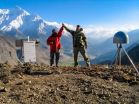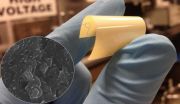Vaccine protects against Ebola when administered 7 days ahead
2015-08-06
(Press-News.org) This news release is available in Japanese.
In the face of the recent Ebola outbreak, some good news emerges: a preclinical study testing the efficacy of the Ebola vaccine VSV-EBOV against the newly emerged West African Ebola strain shows complete protection when administered seven days before infection in nonhuman primates, and partial protection when administered three days before infection. The positive results of this study further reveal the mechanisms by which an effective immune response is mounted against the Ebola virus, aspects of which have been unclear. In the study by Andrea Marzi et al., VSV-EBOV was administered to groups of macaques 28, 21, 14, 7, or 3 days before infection with the Makona strain of Ebola. No adverse effects were detectable after immunization with the lethal dose, and the animals were then monitored for 42 days. The control group, which was administered a vaccine known not to be effective, showed severe symptoms of Ebola and did not survive. One animal in the day-3 VSV-EBOV vaccination group also did not survive, while the other two animals in this group presented mild and moderate symptoms of Ebola but eventually cleared the virus. All nine remaining animals in the day-28, -21, -14, and -7 vaccination groups did not develop any clinical signs of disease. The presence of immunoglobulin G (IgG) antibodies for Ebola has been associated with survival in previous studies; at the time of infection, animals in the day-28, -21 and -14 vaccination groups showed high levels of these Ebola-specific antibodies. Although, day-3 and -7 groups did not have Ebola-specific antibodies at the time of infection, day-3 immunized animals had measurable Ebola-specific IgG antibodies six days after being infected with Ebola, offering them partial protection. Thus, the researchers suggest that the VSV-EBOV vaccine provokes a strong innate immune response that helps limit virus replication during the critical period as the body develops Ebola-specific antibodies. This work shows the potential of this vaccine for rapid deployment to contain any future outbreaks.
INFORMATION:
Article #16: "VSV-EBOV rapidly protects macaques against infection with the 2014/15 Ebola virus outbreak strain," by A. Marzi; S.J. Robertson; E. Haddock; F. Feldmann; P.W. Hanley; D.P. Scott; S.M. Best; H. Feldmann at National Institute of Allergy and Infectious Diseases, National Institutes of Health in Hamilton, MT; J.E. Strong; G. Kobinger at Public Health Agency of Canada in Winnipeg, MB, Canada.
ELSE PRESS RELEASES FROM THIS DATE:
2015-08-06
Darwinian selection can be used to evolve robot controllers able to efficiently self-organize their tasks. Taking inspiration from the way in which ants organise their work and divide up tasks, Eliseo Ferrante and colleagues evolved complex robot behaviors using artificial evolution and detailed robotics simulations.
Just like social insects such as ants, bees or termites teams of robots display a self-organized division of labor in which the different robots automatically specialized into carrying out different subtasks in the group, says new research publishing in PLOS ...
2015-08-06
Big data sets are important tools of modern science. Mining for correlations between millions of pieces of information can reveal vital relationships or predict future outcomes, such as risk factors for a disease or structures of new chemical compounds.
These mining operations are not without risk, however. Researchers can have a tough time telling when they have unearthed a nugget of truth, or what amounts to fool's gold: a correlation that seems to have predictive value but actually does not, as it results just from random chance.
A research team that bridges academia ...
2015-08-06
Autopsies of nearly every patient with the lethal neurodegenerative disorder amyotrophic lateral sclerosis (ALS), and many with frontotemporal dementia (FTD), show pathologists telltale clumps of a protein called TDP-43. Now, working with mouse and human cells, Johns Hopkins researchers report they have discovered the normal role of TDP-43 in cells and why its abnormal accumulation may cause disease.
In an article published Aug. 7 in Science, the researchers say TDP-43 is normally responsible for keeping unwanted stretches of the genetic material RNA, called cryptic ...
2015-08-06
For more than 20 years, Caltech geologist Jean-Philippe Avouac has collaborated with the Department of Mines and Geology of Nepal to study the Himalayas--the most active, above-water mountain range on Earth--to learn more about the processes that build mountains and trigger earthquakes. Over that period, he and his colleagues have installed a network of GPS stations in Nepal that allows them to monitor the way Earth's crust moves during and in between earthquakes. So when he heard on April 25 that a magnitude 7.8 earthquake had struck near Gorkha, Nepal, not far from Kathmandu, ...
2015-08-06
Case Western Reserve scientists may have uncovered a molecular mechanism that sets into motion dangerous infection in the feet and hands often occurring with uncontrolled diabetes. It appears that high blood sugar unleashes destructive molecules that interfere with the body's natural infection-control defenses.
The harmful molecules -- dicarbonyls -- are breakdown products of glucose that interfere with infection-controlling antimicrobial peptides known as beta-defensins. The Case Western Reserve team discovered how two dicarbonyls -- methylglyoxal (MGO) and glyoxal (GO) ...
2015-08-06
ROSEMONT, Ill.--According to a new study in the Journal of the American Academy of Orthopaedic Surgeons (JAAOS), imaging studies necessary to diagnose traumatic injuries sustained by pregnant women are safe when used properly.
During pregnancy, approximately 5 to 8 percent of women sustain traumatic injuries, including fractures and muscle tears. To help evaluate and manage these injuries, orthopaedic surgeons often recommend radiographs and other imaging studies. "While care should be taken to protect the fetus from exposure, most diagnostic studies are generally safe, ...
2015-08-06
Women experience more emotional pain following a breakup, but they also more fully recover, according to new research from Binghamton University.
Researchers from Binghamton University and University College London asked 5,705 participants in 96 countries to rate the emotional and physical pain of a breakup on a scale of one (none) to 10 (unbearable). They found that women tend to be more negatively affected by breakups, reporting higher levels of both physical and emotional pain. Women averaged 6.84 in terms of emotional anguish versus 6.58 in men. In terms of physical ...
2015-08-06
PITTSBURGH-- In the era of launching Kickstarter campaigns to pay for just about anything, Carnegie Mellon University ethicists warn that the trend of patients funding their own clinical trials may do more harm than good.
CMU's Danielle Wenner and Alex John London and McGill University's Jonathan Kimmelman co-wrote a column in Cell Stem Cell outlining how patient-funded trials may seem like a beneficial new way to involve more patients in research and establish new funding opportunities, but instead they threaten scientific rigor, relevance, efficiency and fairness.
"Patient-funded ...
2015-08-06
Easily manufactured, low cost, lightweight, flexible dielectric polymers that can operate at high temperatures may be the solution to energy storage and power conversion in electric vehicles and other high temperature applications, according to a team of Penn State engineers.
"Ceramics are usually the choice for energy storage dielectrics for high temperature applications, but they are heavy, weight is a consideration and they are often also brittle," said Qing Wang, professor of materials science and engineering, Penn State. "Polymers have a low working temperature and ...
2015-08-06
Researchers at USC have developed a yeast model to study a gene mutation that disrupts the duplication of DNA, causing massive damage to a cell's chromosomes, while somehow allowing the cell to continue dividing.
The result is a mess: Zombie cells that by all rights shouldn't be able to survive, let alone divide, with their chromosomes shattered and strung out between tiny micronuclei. Sometimes they're connected to each other by ultrafine DNA bridges. (Imagine tearing apart a hot pizza - these DNA bridges are like strings of cheese still draping between the separated ...
LAST 30 PRESS RELEASES:
[Press-News.org] Vaccine protects against Ebola when administered 7 days ahead

